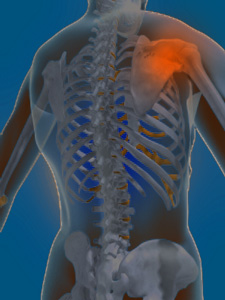
What are Throwing Injuries of the Shoulder?
Throwing injuries of the shoulder are injuries sustained as a result of trauma by athletes during sports activities that involve repetitive overhand motions of the arm as in baseball, American football, volleyball, rugby, tennis, track and field events, etc. Throwing injuries are mostly seen in the shoulder and elbow and can occur due to improper techniques, training errors, muscle imbalance, and overuse of muscles.
Anatomy of the Shoulder
The shoulder is a ball and socket joint that is formed by 3 bones: the humerus (upper arm bone), scapula (shoulder blade), and clavicle (collarbone). The head of the upper arm bone fits into a rounded socket (the glenoid) in the shoulder blade. Surrounding the outside edge of the socket is a rim of tough, fibrous tissue called the labrum that helps to deepen the socket and stabilize the shoulder joint. These bones are joined together by soft tissues (tendons, muscles, ligaments, and joint capsule) to provide a platform for the arm to work.
Causes of Throwing Injuries of the Shoulder
Most problems in the shoulder involve ligaments, muscles, tendons, and joints. Some of the common causes that can be attributed to shoulder injuries include:
- Inflammation of the joints
- Torn cartilage or torn rotator cuff
- Inflammation of the tendons or rotator cuff tendinitis
- Bursitis or swelling of the bursa sacs
- Fractures and dislocations
- Stiffening of the ligaments, muscles, and tendons
- Shoulder instability, a condition where a shoulder joint is forced out or moves out of its normal position
- Impingement, excessive rubbing of shoulder muscles against the shoulder blade
Symptoms of Throwing Injuries of the Shoulder
Common symptoms of throwing injuries of the shoulder may include:
- Loss of range of motion
- Weakness
- Swelling or inflammation
- Persistent discomfort
- Tender to touch at the site of injury
Types of Throwing Injuries of the Shoulder
Athletes in sports like baseball, tennis, and American football are more susceptible to different types of throwing injuries of the shoulder that include:
- SLAP Tears: In a slap injury, the superior part of the shoulder labrum is injured. The labrum is a rim of tough fibrous tissue that stabilizes the shoulder joint. This type of injury commonly occurs in sports with overhead motions as in baseball.
- Tendon Tears and Biceps Tendinitis: Repetitive throwing movement leads to irritation and inflammation of the biceps tendon known as biceps tendinitis. Damage to the tendon may also result in a tear leading to a torn biceps tendon.
- Rotator Cuff Tears and Tendinitis: Overuse of the rotator cuff muscles or tendons results in a rotator cuff tear and tendinitis. This is most commonly observed in baseball throwers due to repeated high-speed throwing activity that adds significant stress on the ligaments and rotator cuff tendons of the shoulder.
- Impingement: During an overhand throwing action as in baseball, the rotator cuff tendons at the back of the shoulder get pinched between the humeral head and the glenoid socket. This is known as internal impingement that leads to partial tearing of the rotator cuff tendon and may also damage the shoulder labrum.
- Instability: Shoulder instability happens when the humeral head slips out of the shoulder socket resulting in dislocation. This is seen in throwers where the instability occurs due to repetitive throwing motions that stretch the ligaments causing increased laxity (looseness).
- Scapular Rotation Dysfunction: This type of injury is mostly noted in throwers where the repeated use of scapular muscles leads to changes in the muscles that affect the position of the scapula resulting in drooping of the affected shoulder.
- Glenohumeral Internal Rotation Deficit (GIRD): In this type of injury, soft tissues in the back of the shoulder tighten leading to loss of internal rotation due to high-speed repetitive throwing action noted in throwers. This puts throwers at greater risk of rotator cuff and labral tears.
Diagnosis of Throwing Injuries of the Shoulder
Your doctor will review your symptoms and medical history and perform a physical examination to check for range of motion, stability, and strength of your shoulder. If necessary, your doctor will order certain imaging tests such as X-rays, MRI, CT scan, or ultrasound to confirm the diagnosis and narrow down any associated problems.
Treatment Involved in Throwing Injuries of the Shoulders
Treatment for throwing injuries of the shoulder include both surgical as well as non-surgical options. Your doctor will decide the best option based on the condition of your shoulder.
Nonsurgical treatment options may include:
- Ice: Application of ice packs on the shoulder to decrease swelling and pain
- Activity Modification: Avoiding activities that trigger symptoms and changing lifestyle
- Physical Therapy: Regular exercise regimen to improve range of motion and strengthen shoulder muscles
- Anti-inflammatory Medication: Meds like naproxen and ibuprofen can relieve inflammation and pain.
- Cortisone Injection: If physical therapy, medications, rest, and activity modification do not yield the desired results, then a cortisone injection may be helpful. Cortisone is a very effective anti-inflammatory medicine for bursitis and long-term pain reliever for tears and structural damage.
Surgical treatment options may include:
- Arthroscopy: Most throwing injuries can be treated with arthroscopic surgery. Your doctor will be able to repair damage to soft tissues, such as ligaments, labrum, or rotator cuff tears by using this technique. Arthroscopy is a minimally invasive surgical procedure that involves making small keyhole incisions to pass a fiber-optic tube with a tiny camera called an arthroscope and miniature instruments into the shoulder joint. The camera displays pictures of the affected region on a television screen and the doctor uses these images to carry out the surgery.
- Open Surgery: A traditional open surgery approach would require a large surgical incision to be made to repair the affected region if the injury is large and complex.






